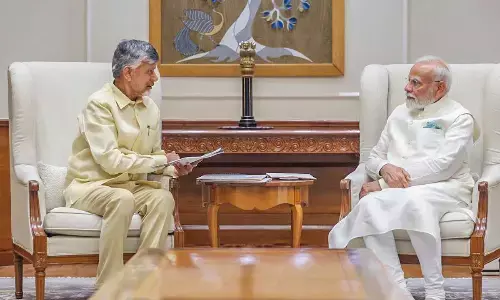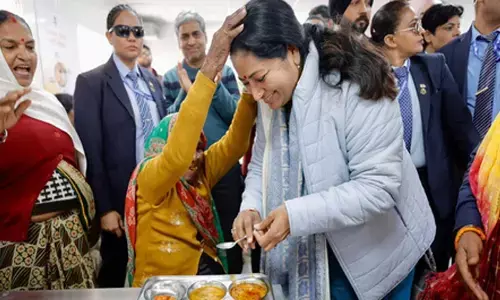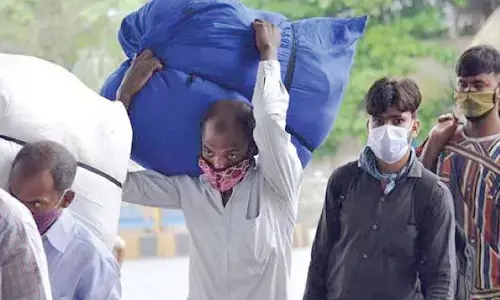Sorry story of saree makers

Sorry story of saree makers. Ever since I have come back from Mangalagiri, the temple town located 11 kilometres from the city of Vijayawada in Andhra Pradesh that is best known for producing wonderful handloom sarees, I have a new respect for the talents of the hardworking weavers who bring to life intricate designs and rich colours of the Mangalagiri saree.
.jpg) Ever since I have come back from Mangalagiri, the temple town located 11 kilometres from the city of Vijayawada in Andhra Pradesh that is best known for producing wonderful handloom sarees, I have a new respect for the talents of the hardworking weavers who bring to life intricate designs and rich colours of the Mangalagiri saree. It is not the prices of the sarees that I remember, but the sweat and labour that goes into making them. I can clearly recall the vivid image of Sivaramakrishna sitting at his pit loom making a deep magenta-hued saree. “I have been doing this for 40 years,” he told me with a smile, “I weave one saree in two days and get paid Rs 300 per piece.”
Ever since I have come back from Mangalagiri, the temple town located 11 kilometres from the city of Vijayawada in Andhra Pradesh that is best known for producing wonderful handloom sarees, I have a new respect for the talents of the hardworking weavers who bring to life intricate designs and rich colours of the Mangalagiri saree. It is not the prices of the sarees that I remember, but the sweat and labour that goes into making them. I can clearly recall the vivid image of Sivaramakrishna sitting at his pit loom making a deep magenta-hued saree. “I have been doing this for 40 years,” he told me with a smile, “I weave one saree in two days and get paid Rs 300 per piece.” Sivaramakrishna was living in the weavers’ colony and working for a master craftsman as a daily wage labourer. “Most of us weavers do this. There are a few independent weavers who make and sell sarees on their own but very often they too come to master craftsmen to sell their products. When you are on your own, it is difficult to invest in yarn, then dye and dry it, weave the fabric and then finally approach the market with your product,” he explained.
What sets the Mangalagiri saree apart from its heritage counterparts? It’s the sparkling border, specifically called the Nizam border that is woven with zari. It is a tough task, one that requires precision and patience. As it is used only for making the border, the zari thread is wound around the bobbin on the loom. Another striking aspect of this weave is that while the body of the saree is generally plain, it is often double-coloured. I was surprised to see the weaver use green yarn for the warp and navy blue for the weft to produce a bottle green saree. Similarly, for the magenta saree, Sivaramakrishna used a combination of bright red and a shade of purple.
The co-operative I had visited housed around 12 pit looms. A pit loom is where the weavers sit on the ground, with the loom placed before them. Their legs are in a pit below the structure. According to the craftspersons, this position best enabled them to put just the right amount of pressure required to make the incredible nizam border.
The weavers of Mangalagiri source their yarn from neighbouring Chirala, another well-known weavers’ town, and Namburu. “After it is dyed we bring the wet yarn and dry it on the loom,” Sivaramulu, another weaver with the co-operative, revealed. Sure enough, there were hanks of yarn hanging out to dry on bamboo sticks around the room. Yet, curiously, they were all of a single colour. “Every day we pick a different colour to dye the yarn in,” Sivaramulu explained. He added, “We do not use it until it is completely dry. If there is even a little bit of moisture remaining, the saree will not last long.”
Outside the cooperative, a sea of colour met one’s eyes, as yarn had been stretched out for drying there, too. This thread is used as the warp. Once this yarn is ready only then can the weaving begin. Did their womenfolk contribute to this process? “Women do weave but their numbers are fewer. Earlier, they used to help in dyeing and drying but, today, thanks to the power looms, that work has been formally outsourced,” one weaver told me.
Although handloom weaving is skilled work, it is labour intensive and the returns are very low. That was why many of the weavers I had met confided that they did not want their children to follow in their footsteps. “My children have not taken to this profession,” Sivaramakrishna stated in a matter of fact way, “One is a software engineer in Vijayawada and the other is employed in Guntur in the government. The reason I did not encourage them to do this work is that my trade does not have a market any longer. The minimum rate at which I can sell the saree I am weaving is Rs 800. But a similar saree woven on a power loom will cost only Rs 500 or even less. I weave one saree in two days, the power looms weave hundreds. So the demand for handloom sarees has gone down. Power looms still thrive. Demand for their work has increased with a rising interest in ethnic wear and indigenous designs.”
The story is similar for most families here. Sivaramakrishna elaborated, “Where there were 20,000 families involved in this line of work, now we are just about 8,000 left. We belong to the Padma Saliya caste. Of the 8,000 weavers, 80 per cent are old like me. Few youngsters are willing to do the laborious job that we have been doing for years now, slowing honing our skills and perfecting our craft. To me, however, it still has a unique charm. I can say with immense pride that the saree I weave will last forever. The product off the power looms will only last a few years,” Sivaramakrishna elaborated. “Yet, sadly, even though our sarees will last forever our craft may not,” a co-worker added wryly.
In this age of consumerism, where old crafts should have found new markets, quite the opposite has happened because of fast changing trends and fashion sensibilities. “In the old days, women used to own fewer sarees and they wore them till they simply tore. They valued our products. It was a tradition that whoever came to visit the temple of Lakshmi Narasimha bought a saree before she left. That kept our craft alive and sustained us,” Sivaramakrishna said.
Mangalagiri, which literally means auspicious hill, is home to one of the most ancient temples of region, the Lakshmi Narasimha Swamy temple. Devotees have been thronging here since the ages and they continue to queue up for ‘darshan’ throughout the day even today. The difference, however, is that once they are done with appeasing the deities they do not head to one of the cooperatives offering Mangalagiri sarees but make a beeline to one of the spiffy showrooms that line the market. The showrooms sell both handloom and power loom outputs so the direct benefit to the weavers gets reduced considerably.
Sivaramakrishna told me that while he generally made sarees but sometimes he also wove yardage. “But whatever we weave the output is similar and our textile always has a border,” he concluded.
In a shop in town, I met Lakshmi, a bright-eyed salesgirl. She gave me an idea of the retail side of the operations, “We buy sarees from both the handlooms and power looms. And, in addition to the traditional stuff, we have also started value-adding by ordering printed sarees. The Jaipur prints do well and there are units that cater to this changed demand.” Of course, the power looms have started using silk yarn, too, to give the Mangalagiri a different spin. The silk sarees are lighter than their cotton counterparts.
Having met the weavers and visited quite a few cooperatives and boards of master craftsmen, like most tourists I did head to the temple for the customary prayers. But that was not all. I did manage to catch up with the famous Ayurvedic doctor in town whose trademark Sastry balm work like magic to end headaches, colds and even joint pains. Unfortunately, the miraculous balm cannot remove the pains and problems of Mangalagiri’s heritage weavers!
Next Story




















